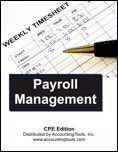domingo, 17 de enero de 2021
jueves, 14 de enero de 2021
3 Desde Alerta de la Fundación IFRS
| February 2021 SME Implementation Group meeting papers available |
| Second Comprehensive Review of the IFRS for SMEs Standard The IFRS for SMEs Standard SME Implementation Group |
lunes, 11 de enero de 2021
4 Desde HBR
| Today’s Tip |
| Do You Really Hate Your New Job, or Is It Just Growing Pains? |
| Starting a new job is exciting — but it doesn't always go according to plan. What should you do if you find yourself feeling disappointed in the first few weeks of your new gig? First, remember no matter your previous experience, you’re likely to encounter tasks or processes that you're not prepared for. Don't panic. A learning curve is inevitable and rarely means you're actually unqualified for the role. Instead, assume that learning is part of getting acclimated and ask for help when you need it. It may be useful to keep a running log of your performance so that you can determine whether you’re actually making progress. Second, one of the hardest things to figure out during the interview process is the company’s underlying values and whether they match with yours. This can take time to assess, so don’t jump to conclusions. But keep an eye on it because a lack of fit with your values is often hard to remedy. If these issues persist six months into your new job, it may be time to make another change. In that case, don't let fear hold you back. Sometimes things just don't work out. |
| This tip is adapted from “Give It Time Before Deciding You Hate Your New Job,” by Art Markman |
12 Desde Data Science Central
- Deep visualizations to Help Solve Riemann's Conjecture
- Facial Recognition Biometric Technology gaining wide popularity for advertising and marketing
- How the Blend of Artificial Intelligence and Big Data Is Helping Industries During The Pandemic
- Triumvirate – AI, IoT, and Blockchain – Converge to Revolutionize Global Businesses!
- Encyclosearch.org is launched
- How Data Science Ensures that Customer’s Needs are Always at the Forefront
- Are You Excited About Getting Vaccinated? Don’t Let Overconfidence Make You A Super Spreader!
- Women in Politics | Exploratory Data Analysis in R
- FinTech: How AI is Improving This Industry
- Top Advanced Analytics Use Cases
- How poor data quality impacts your business?
- 20 Of The Most Important Machine Learning Interview Questions and Answers
- Data Science Central Weekly Digest, 4 Jan 2021
FinTech: How AI is Improving This Industry
FinTech has achieved staggering growth levels over the past few years, establishing itself as one of the mainstays of the modern world. And as customers become more and demanding and the competition in the market continues to rise, the focus on this sector and the many technologies that aid and enable it has grown too. Take artificial intelligence and machine learning, for example; this potent technology has already demonstrated a wide scope of application in this sector, especially thanks to its ability to execute tasks that generally need human intelligence. Now, as the FinTech industry also becomes increasingly popular, its union with AI was only a matter of time.
In fact, according to a recent study, AI’s share in the FinTech sector will touch about $35.4 billion in value by 2025. This staggering figure begs the question: What exactly is artificial intelligence contributing to the financial technology market? Well, the answer to that question is: Plenty. For starters, FinTech companies all over the world are now tapping into artificial intelligence to offer enhanced services, such as online financial coaching and advice, to their customers. Now, allow us to walk you through some of the other critical AI applications in this industry.
- Fraud prevention: As the market offers an increasing number of mediums for transactions, fraud concerns have also gone up. AI can tend to these concerns since it can identify fraudulent activities based on the already established baseline for standard customer behavior. It, then, not only flags such potential transactions but also enables measures aimed at the prevention of fraudulent activities.
- Automatic claim process: To offer tailored services to customers, financial institutions are now using AI to provide exceptional, high-quality services. Case in point, automation of the claims process. AI-based chatbots help with that by engaging with customers, collecting data, evaluating the claim's veracity, and triggering the claim process. This not only accelerates the whole process but also allows employees to focus on other essential tasks.
- Customer support: It is unlikely you have missed business’s increase in customer experience in the past decade or so. This has been an essential area of focus for the FinTech market as well. But how is the sector going about it? With help from artificial intelligence, of course. AI has brought along a plethora of tools, including intelligent chatbots, that serve to ensure the delivery of top-notch customer support round the clock. A study predicts that AI can also help the FinTech industry save as much as 22 percent costs too. That’s about $1 trillion, in case you were wondering.
As the world continues to generate a staggering amount of data with every passing day, the scope of AI application in this sector is bound to grow for the foreseeable future. And suppose you too wish to leverage it to your company’s benefit. In that case, we recommend engaging the services of an expert fintech application development company at the earliest.
jueves, 7 de enero de 2021
12 Desde Data Science Central
The stories of bias in AI are everywhere: Amazon’s recruiting tool, Apple’s credit card limits, Google’s facial recognition, and dozens more. The quick solution is just to blame the algorithm and its designers. But it’s not a question of whether or not you have bias in your institution, but rather how you plan to handle it.
In part 2 of 2 of this latest Data Science Central podcast, ‘How to Start Tackling AI Bias, Part 2: Building Fair AI’, Jett Oristaglio, Data Science Product Lead of Trusted AI at DataRobot, takes a deeper dive into how to tackle AI bias, including:
- How machine learning can highlight implicit bias in institutions and using AI to measure and change it
- Implementing a practical plan to improve your AI development and increase trust in your AI
| Download Now > |
44 Desde The Chronicle of Higher Education
PAID FOR AND CREATED BY MODERNTHINK
YOUR PEOPLE ARE STILL YOUR GREATEST ASSET.
An opportunity to engage with your employees, the Great Colleges to Work For program addresses pillars of engagement like communication, well-being, diversity and inclusion, helping you fulfill goals in your strategic plan.
4 Desde HBR
| Today’s Tip |
| Ask These Questions Before Collaborating with a New Colleague |
Collaborating with someone you haven’t met before can be awkward. You may feel inclined to simply introduce yourself and "get to work." But before you dive into your joint project, spend some time getting to know each other better, so you can work together more effectively. (An hour is usually enough.) Here are some questions to guide that conversation:
|
| This tip is adapted from “Collaborating with Someone You Don’t Really Know,” by Rebecca Zucker |
miércoles, 6 de enero de 2021
12 Desde Data Science Central
The toughest part of being an analyst isn’t building the dashboard; it's getting data into a state where you can gain insights. Data is messy and often scattered across multiple platforms, making the back end work frustrating and time-consuming.
In part one of the Wrangle the Data Abyss series, we take a deep dive into the most important and often overlooked step of the analytics process: scoping.
Listen to this latest Data Science Central podcast to learn how to best handle initial requests, thoroughly evaluate the available data, and create a plan for success.
Speaker: Lauren Alexander, Senior Marketing Analyst - Tableau Hosted by: Sean Welch, Host and Producer - Data Science Central |
| Download Now |
39 Desde Edutopia
The Benefits of Developing a Reflective Routine |
Teachers who take time daily to reflect on what worked in class and what didn’t can better assess areas for improvement and begin to make necessary adjustments. |
martes, 5 de enero de 2021
48 Desde Deloitte Insights
|
Global economic update
What's happening this week in economics? Deloitte’s team of economists examines news and trends from around the world. This week we continue our coverage of how COVID-19 is impacting the economy in:
- United States
- European Union
- United Kingdom
- China
- Emerging markets
32 Desde Accounting Tools
|
January Course Discount
This newly-updated course shows the accountant how to improve the functions of the payroll department, enhancing efficiency and reducing error rates. Topics covered include time tracking, payroll processing, procedures, controls, and recordkeeping. The course also addresses the United States payroll regulations and reporting requirements related to compensation, benefits, payroll taxes, and tax remittances. It is updated annually for the latest payroll regulations.
(14 CPE hours)
44 Desde The Chronicle of Higher Education
IN CASE YOU MISSED IT Distracted Minds: Why You By James M. Lang |
4 Desde HBR
| Today’s Tip | |
| Just Breathe | |
| In the run-up to the new year, we’re resharing some of our favorite tips from 2020. | |
| This tip is adapted from “Research: Why Breathing Is So Effective at Reducing Stress,” by Emma Seppälä et al. |
sábado, 2 de enero de 2021
17 Desde McKinsey & Company
| Strategy & Corporate Finance | |||
| 2020 is officially behind us—with back-to-work just around the corner—so what better time to revisit our most popular articles of last year. This continuing top ten series spans the best of McKinsey Quarterly, the McKinsey Global Institute, the New at McKinsey blog, and more—we even feature an Editor’s Choice category. Today, we give you our best-read pieces on strategy and corporate finance, which revolved around leaders’ response to the COVID-19 crisis, touching on everything from safeguarding lives and livelihoods to digital strategy and innovation. Read on for our full top ten.
|
viernes, 1 de enero de 2021
52. Desde TechTarget
| ||||
| ||||
| ||||
| ||||
2 Desde GIC
Fundamentos de Auditoría Interna
Reseña
recopilada por Javier Enrique Miranda Rivera
PARTE 1 DOC 1
Orientación obligatoria
&&&&&&&&&&&&&&&&&&&&&&&&&&&&&&&&&&&&&&&&&&&&&&&&&&&&&
Definición de auditoría interna
La definición globalmente aceptada
de auditoría interna establece el propósito fundamental, la naturaleza y
alcance de la auditoría interna:
La auditoría interna es una
actividad independiente y objetiva de aseguramiento y consultoría. diseñada
para agregar valor y mejorar las operaciones de una organización. Ayuda a una
organización a lograr sus objetivos aportando un enfoque sistemático y
disciplinado para evaluar y mejorar la eficacia de los procesos de gestión de
riesgos, control y gobernanza.
&&&&&&&&&&&&&&&&&&&&&&&&&&&&&&&&&&&&&&&&&&&&&&&&&&&&&&&&&&
Estándares internacionales
La auditoría interna se realiza
en diversos entornos legales y culturales; dentro de las organizaciones que
varían en propósito, tamaño, complejidad y estructura; y por personas dentro o
fuera de la organización.
Si bien las diferencias pueden
afectar la práctica de la auditoría interna en cada entorno, la conformidad con
las Normas Internacionales para la práctica Profesional del Instituto de
Auditores Internos, es esencial para cumplir con las responsabilidades de
auditores y de la actividad de auditoría interna.
Si la ley o el reglamento prohíbe
a los auditores internos o la actividad de auditoría interna cumplir
con ciertas partes de las Normas,
se debe lograr la conformidad con todas las demás partes de las Normas y se
necesitan divulgaciones apropiadas.
Si las Normas se utilizan junto
con normas emitidas por otros organismos autorizados, las comunicaciones de
auditoría interna también pueden citar el uso de otras normas, según
corresponda. De tal caso, si existen inconsistencias entre las Normas y otras
normas, los auditores internos y la actividad de auditoría interna debe
ajustarse a las Normas y puede ajustarse a las demás normas si son más
restrictivas.
&&&&&&&&&&&&&&&&&&&&&&&&&&&&&&&&&&&&&&&&&&&&&&&&&&&&&
El propósito de las Normas es:
◾◾Delinear los principios
básicos que representan la práctica de la auditoría interna.
◾◾Proporcionar un marco para
realizar y promover una amplia gama de funciones de auditoría interna de valor
agregado.
◾◾Establecer las bases para la
evaluación del desempeño de la auditoría interna.
◾◾ Fomentar procesos y
operaciones organizacionales mejorados.
Los Estándares son requisitos
obligatorios centrados en principios que consisten en:
◾◾ Declaraciones de requisitos básicos
para el ejercicio profesional de la auditoría interna y para
evaluar la efectividad del
desempeño que son internacionalmente aplicables a nivel organizacional
y niveles individuales.
◾◾ Interpretaciones que aclaran
términos o conceptos dentro de las Declaraciones.
Las Normas emplean términos a los
que se les ha dado significados específicos que se incluyen en el Glosario.
Específicamente, los Estándares usan la palabra "debe" para especificar
un requisito incondicional y la palabra "debería" donde se espera la
conformidad a menos que, cunado se aplique el juicio profesional, las
circunstancias justifiquen la desviación.
Es necesario considerar las
Declaraciones y sus Interpretaciones, así como los significados específicos del
Glosario, para comprender y aplicar los Estándares correctamente.
La estructura de los Estándares
se divide entre Estándares de Atributo y de Desempeño.
Los estándares de Atributo
abordan los atributos de las organizaciones y las personas que realizan
Auditoría interna (numerados del
1000 al 1322). Los estándares de desempeño describen la naturaleza de la
auditoría interna y proporcionar criterios de calidad contra los cuales el
desempeño de estos servicios pueda ser medido (numerado de 2000 a 2600). Los
Estándares de Atributo y Desempeño también son proporcionados para aplicar a
todos los servicios de auditoría interna.
También se proporcionan
estándares de implementación para expandir los Estándares de atributos y el
desempeño, proporcionando los requisitos aplicables a las actividades de
aseguramiento (A) o consultoría (C).
Los servicios de aseguramiento
involucran la evaluación objetiva de la evidencia por parte del auditor interno
para proporcionar una Opinión o conclusión independiente sobre una entidad,
operación, función, proceso, sistema u otro tema. La naturaleza y el alcance
del encargo de aseguramiento están determinados por el auditor interno.
Generalmente hay tres partes involucradas en los servicios de aseguramiento:
(1) la persona o grupo directamente involucrado con la entidad, operación,
función, proceso, sistema u otro sujeto materia de estudio: el propietario del
proceso; (2) la persona o grupo que realiza la evaluación: el auditor interno;
y (3) la persona o el grupo que utiliza la evaluación: el usuario.
Los servicios de consultoría son
de carácter consultivo y generalmente se realizan específicamente por la
solicitud de un cliente del encargo. La naturaleza y el alcance del trabajo de
consultoría son sujeto de un acuerdo con el cliente del encargo. Los servicios
de consultoría generalmente involucran dos Partes: (1) la persona o grupo que
ofrece el asesoramiento: el auditor interno; y (2) la persona o grupo que busca
y recibe el asesoramiento: el cliente del encargo. Al realizar servicios de
consultoría, el auditor interno debe mantener la objetividad y no asumir
responsabilidad de la gestión.
.
&&&&&&&&&&&&&&&&&&&&&&&&&&&&&&&&&&&&&&&&&&&&&&&&&&&&&
Referencias:
Argueta, J. (2020). Taller CIA.
IAI El Salvador
Havels Learning System. (2019). CIA Exam. QB.
TestKing. (2015). CIA. Exam.
Vallabhaneni, S. (2014). CIAexcel Exam. Wiley.
Vallabhaneni, S. (2014). Focus Note. CIAexcel Exam. Wiley.
Zain, M. (2019). Practice of Internal Auditing.
Zakaria, R. (2014). How to perform risk based
Internal auditing.
40 Desde The Conversation
It takes a lot of energy for machines to learn – here’s why AI is so power-hungry
Kate Saenko, Boston University
Training neural networks burns through a lot of energy. As the AI field grows, it's working to keep its carbon foot print from growing with it.
































